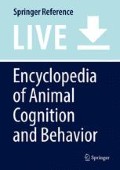References
Glaudas, X., & Alexander, G. J. (2017). A lure at both ends: Aggressive visual mimicry signals and prey-specific luring behaviour in an ambush-foraging snake. Behavioral Ecology and Sociobiology, 71, 2.
Haynes, K. F., Gemeno, C., Yeargan, K. V., Millar, J. G., & Johnson, K. M. (2002). Aggressive chemical mimicry of moth pheromones by a bolas spider: How does this specialist predator attract more than one species of prey? Chemoecology, 12, 99–105.
Jackson, R. R., & Cross, F. R. (2013). A cognitive perspective on aggressive mimicry. Journal of Zoology, 290, 161–171.
Jackson, R. R., & Hallas, S. E. A. (1986). Comparative biology of Portia africana, P. albimana, P. fimbriata, P. labiata, and P. shultzi, araneophagic, web-building jumping spiders (Araneae: Salticidae): Utilisation of webs, predatory versatility, and intraspecific interactions. New Zealand Journal of Zoology, 13, 423–489.
Jackson, R. R., & Wilcox, R. S. (1990). Aggressive mimicry, prey-specific predatory behaviour and predator recognition in the predator-prey interactions of Portia fimbriata and Euryattus sp., jumping spiders from Queensland. Behavioral Ecology and Sociobiology, 26, 111–119.
Jackson, R. R., & Wilcox, R. S. (1993). Spider flexibly chooses aggressive mimicry signals for different prey by trial and error. Behaviour, 127, 21–36.
Lloyd, J. E. (1975). Aggressive mimicry in Photuris fireflies: Signal repertoires by femmes fatales. Science, 187, 452–453.
Tarsitano, M., Jackson, R. R., & Kirchner, W. H. (2000). Signals and signal choices made by the araneophagic jumping spider Portia fimbriata while hunting the orb-weaving web spiders Zygiella x-notata and Zosis geniculatus. Ethology, 106, 595–615.
Wignall, A. E., & Taylor, P. W. (2011). Assassin bug uses aggressive mimicry to lure spider prey. Proceedings of the Royal Society of London Series B, 278, 1427–1433.
Wilson, D. P. (1937). The habits of the angler-fish, Lophius piscatorius L., in the Plymouth aquarium. Journal of the Marine Biological Association of the United Kingdom, 21, 477–496.
Author information
Authors and Affiliations
Corresponding author
Editor information
Editors and Affiliations
Section Editor information
Rights and permissions
Copyright information
© 2018 Springer International Publishing AG, part of Springer Nature
About this entry
Cite this entry
Cross, F.R. (2018). Aggressive Mimicry. In: Vonk, J., Shackelford, T. (eds) Encyclopedia of Animal Cognition and Behavior. Springer, Cham. https://doi.org/10.1007/978-3-319-47829-6_113-1
Download citation
DOI: https://doi.org/10.1007/978-3-319-47829-6_113-1
Received:
Accepted:
Published:
Publisher Name: Springer, Cham
Print ISBN: 978-3-319-47829-6
Online ISBN: 978-3-319-47829-6
eBook Packages: Springer Reference Behavioral Science and PsychologyReference Module Humanities and Social SciencesReference Module Business, Economics and Social Sciences

